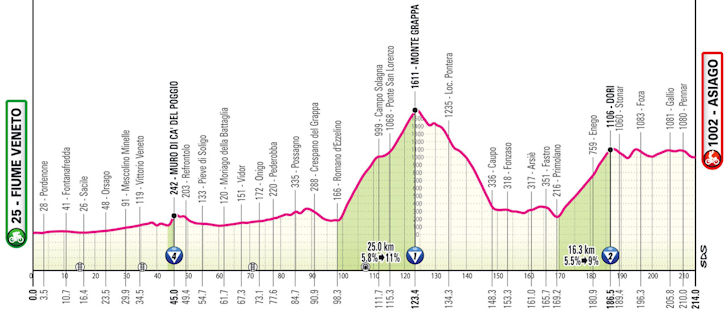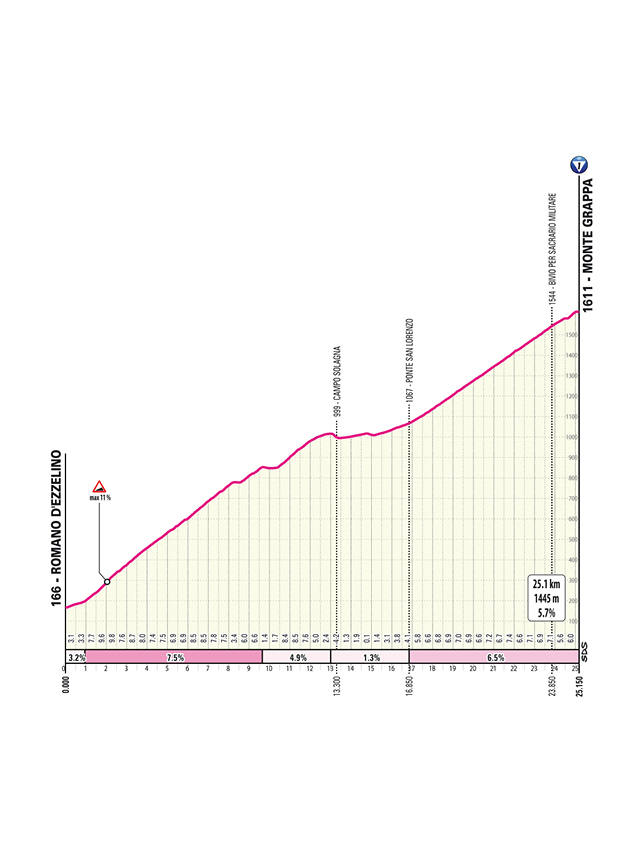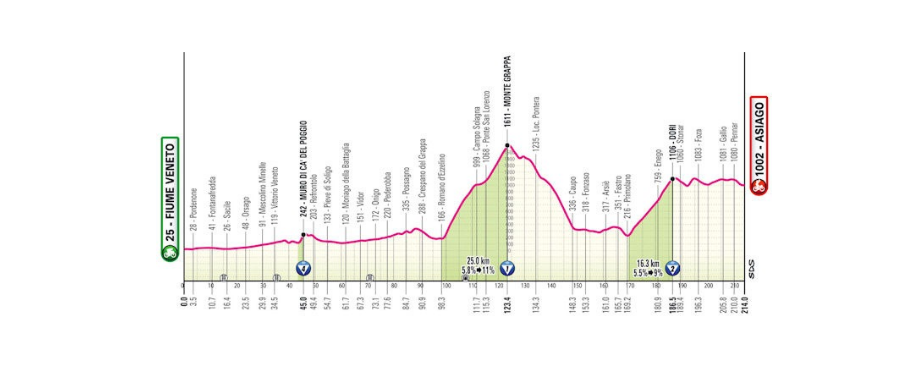The 15th stage of Giro d'Italia 2025 will be held on 25th May 2025.
it will be a 219 km long mountain stage between Fiume Veneto and Asiago.
The program of the stage will include Monte Grappa.

MONTE GRAPPA IN THE PROGRAM OF GIRO D'ITALIA
Monte Grappa was introduced to Giro d'Italia in 1968. Seven times it was part of the program. The most recent occasion was a double challenge during Giro d'Italia 2024.
Read more about Monte Grappa and the Giro d'Italia>>
MONTE GRAPPA PROFILE

NEXT STAGES
Giro d’Italia 2025 Stage 16 Piazzola sul Brenta – Brentonico (203 km)
The 16th stage of Giro d’Italia 2025 will be held after the last rest day, on 26 May… Read More »Giro d’Italia 2025 Stage 16 Piazzola sul Brenta – Brentonico (203 km)
Giro d’Italia 2025 Stage 17 San Michele all’Adige – Bormio (155 km)
Another day in the mountains. Stage 17 of Giro d’Italia 2025 between San Michele all’Adige and Bormio on… Read More »Giro d’Italia 2025 Stage 17 San Michele all’Adige – Bormio (155 km)
Giro d’Italia 2025 Stage 18 Morbegno – Cesano Maderno
18th stage Morbegno – Cesano Maderno 29 May 2025
OTHER HILLIY OR MOUNTAIN STAGES
Giro d’Italia 2025 Stage 11 Viareggio – Castelnovo ne’ Monti (185 km)
Viareggio – Castelnovo ne’ Monti 21 May 2025 185 km IMPORTART CLIMB OF THE DAY GENERAL… Read More »Giro d’Italia 2025 Stage 11 Viareggio – Castelnovo ne’ Monti (185 km)
Giro d’Italia 2025 Stage 19 Biella – Champoluc
19th stage of Giro d’Italia 2025 on 30 May 2025
Giro d’Italia 2025 Stage 20 Verrès – Sestriere
The penultimate stage of Giro d’Italia 2025 leads up to Sestriere.
WHEN WILL THE BIG MOUNTAINS COME?
The big mountains - at least one of them, Monte Grappa - are here.
The peloton has arrived in the Dolomites. However, Stage 15 provides a rather decent program before the third and final rest day of the race.
The real fight in the mountains will begin only after the break.
Stage 16 will end on San Valentino, this will be the first proper hilltop finish of this year's Giro d'Italia edition.
Stage 17 will include only two big climbs, but what climbs! Passo del Tonale and Passo del Mortirolo!
After the last chance for rhe sprinters for a stage victory on the next day (Stage 18), Stage 19, already in the French Alps region will provide several monstrous ascents.
While the penultimate tappa, Stage 20 will give us Colle delle Finistre and he last hilltop finish in Sestrière.
IF YOU CAN'T STOP THINKING ABOUT THE ROMAN EMPIRE
While the Roman Empire is often associated with grand cities and monumental architecture,
its influence also extended into the mountainous regions of northern Italy, such as the Asiago Plateau.
Though these areas were less urbanized, they held strategic and economic importance for Rome. The Romanization of the mountains was a gradual process, shaped by military control, cultural integration, and economic adaptation.
The Asiago region was originally inhabited by Celtic and Raetian tribes. Rather than founding cities, the Romans established control through a network of military roads, forts, and watchposts, allowing safe passage through the Alps and linking Italy with northern provinces like Noricum and Raetia. Control of key mountain passes was essential for trade and defense.
Cultural integration occurred over generations. Local elites were often assimilated into Roman society through citizenship, military service, and the adoption of Roman customs. Archaeological evidence, such as Roman pottery, coins, and tools, has been found in highland settlements, reflecting the spread of Roman material culture. Latin language and Roman religious practices also mixed with local traditions. In some cases, Roman gods were merged with indigenous deities, as seen in altars and votive offerings found near sacred springs or mountain passes.
Economically, the highlands were valuable for seasonal grazing, forestry, and mining. The Romans continued and formalized transhumance—the practice of moving livestock to high pastures during summer—which was likely already part of local life. This blend of local and Roman practices helped sustain imperial control in these remote areas.




